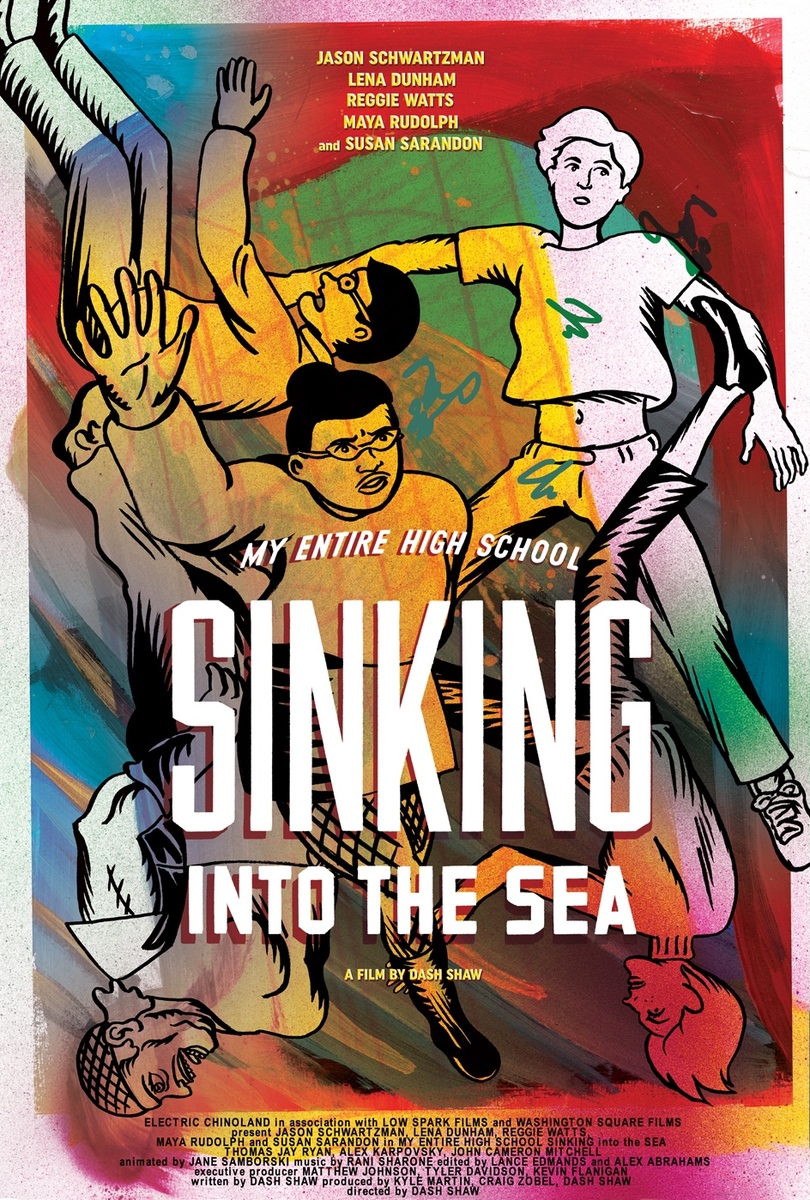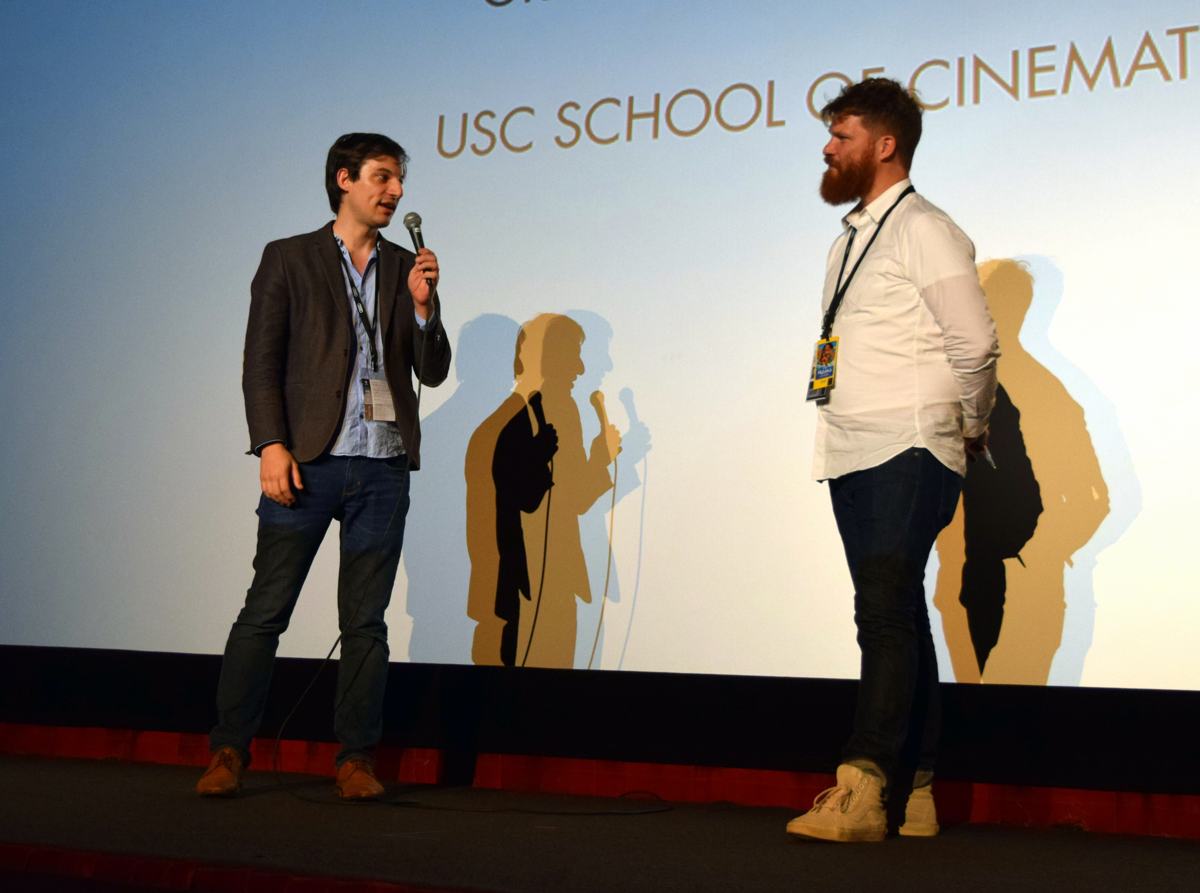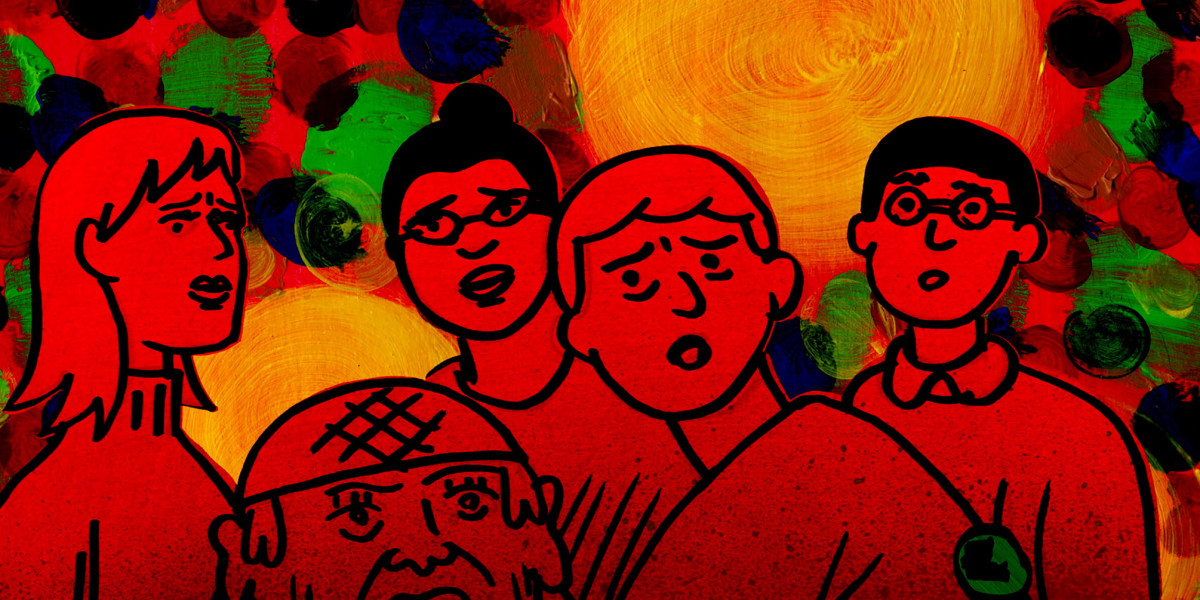
Dash Shaw
by Lily and Generoso Fierro
We have long praised the comics of Dash Shaw. After our introduction to Shaw’s intriguing, layered visual style through Three New Stories, we have always kept an eye out for any of his creations. Consequently, when we heard that his debut feature film, My Entire High School Sinking Into the Sea, would screen at AFI Fest 2016, we were excited to see it, and we were even more excited to get the opportunity to sit down and speak with him at the Roosevelt Hotel in Hollywood about his approach to image-making. My Entire High School Sinking Into the Sea is lighter in tone than books such as Doctors or Bottomless Belly Button, but it condenses all of Shaw’s clever, innovative visual techniques into a hypnotic array of animated sequences, conveying Shaw’s and lead animator Jane Samborski’s abilities to create and experiment within a time-based visual medium.
• •
Lily Fierro : For those who are familiar with your comics work, could you explain where the development of My Entire High School Sinking Into the Sea falls into the course of your career? Did you start working on it at the same time as New School?
Dash Shaw : Well, My Entire High School Sinking Into the Sea originated as a comic short story that I had written around 2008, and the initial impetus for it was that when I was a teenager in the ’90s, the main kind of opposing schools of comics were the alternative comics that were mostly autobiographical and the mainstream, boys’ adventure, superhero comics, and I liked both of them, so the joke of the story was that I combined the two. It had a character named Dash, but it was clearly showing his warped fantasy view, so it engaged and combined both of those schools. I tried to make another animated movie, a different one for many years, starting around 2007, and I did an IFC series in 2009, but I was thinking about making an independent movie as soon as I saw that the tools to do so were easily accessible using a scanner instead of a camera and using Photoshop to make traditional animation with a computer. Up until that time, all of the computer animation that I had seen looked too “computery,” so when I figured out that I could scan a painted background, and it could look the way I really wanted it to, I was encouraged, and then I was off and running, but the discovery of the creation process I wanted, overall, took a long time.
I did the Sundance Labs in 2010 on a different project, which ultimately didn’t get made, but during that same year, I wrote the script for My Entire High School Sinking Into the Sea. BodyWorld had just come out at the time, and I was working on New School and Cosplayers while I was making this movie, which took many years to finish. I picked this story because it felt the most doable; even though a lot of other great artists worked on the project and painted backgrounds, I initially didn’t know that they would come onboard to help finish the film. This story all takes place in a school, and I thought that it was completely feasible to paint all these backgrounds myself because I was not sure if, in the long run, I would be able to communicate what I truly wanted to other artists who may work on the project. I thought of My Entire High School Sinking Into the Sea like Sam Raimi’s Evil Dead—we see that he had a cabin locked in for the setting and very limited means, but the film gets by on energy and enthusiasm.
So with my film, it felt doable with what I had and what I thought I could do by shooting as much energy into the movie; even though it’s only composed with drawings, I felt the film could succeed based on how energetic those drawings could be. We only had the actors come to the project in 2014, and by then, I already had a majority of the movie drawn. And then, I re-drew things based on what the actors provided and had them come back to record more, creating this cycle of my drawing updates based on their recordings, which repeated until the film was completed. I hope the next one will be faster.

L. Fierro: With the total creation process spanning over such a long time, did the story change over time, or did you have fixed storyboards in place?
The good thing about my animation process is that everything is malleable. If I needed a shot, I could paint it and stick it in, and there was a lot of that. It was boarded around 2011; the boards were made in color markers, so there were indications of how the film would look, but My Entire High School Sinking Into the Sea changed like a collage made over time. I would have one background in place, and a year later, Andrew Lorenzi, a great artist, would re-paint that background and make it better, and then a year after that, I would think, “Oh, this figure could go there,” so I would draw it and plug it in. The whole creation process was very collage-like.
L. Fierro: In terms of the acting, which eventually influenced your drawing calibrations for the film, we understand that you met Jason Schwartzman through your comics work. Given the character of Dash and the plot of My Entire High School Sinking Into the Sea, was Max Fischer from Rushmore in your mind when you approached him for the voice of your character?
Strangely, I didn’t. Another reason why I felt the movie was doable was that I didn’t think I would get major actors for the parts. I thought I would be able to just record it with friends, so I tried to write a script that was basically like an action movie in its simplicity, but with the joke that even though the movie is centered on a disaster, the characters continue to speak mostly about high school stuff, their writing, and books. With that script, I thought that I could do it with people I know, and it would be interesting in an experimental theater way where there’s this dissonance between how people are reacting and what is going on around them.
Then, I realized I had Jason’s email, and Jason, Lena Dunham, and John Cameron Mitchell, who I work with often, understood the sensibility of the movie because of their familiarity with my work, and when we went to people we didn’t know, they thankfully understood that sensibility as well. In approaching the actors who would suit the part, I thought to myself, “Would this actor have hung out with me eight years ago? Would this actor be drawn to the material?”
Jason, who would have played all of these writers and had that sensibility that we know from these other movies, also is the kind of person who would hang out with a comic book artist. And so, when he came on board, I was absolutely delighted because I think he is great, and the reason why he’s played a lot of writers and why we recognize these other characters he’s played in those roles is that there’s something genuinely writerly about him. He would want to hang out with me from having made books, and in the recording sessions, he was very good at altering words in sentences because he’s a writer himself, so he was the perfect person for the role of Dash.

Generoso Fierro : I had not realized that you have worked with John Cameron Mitchell (Shortbus, Hedwig and the Angry Inch). What are the works that you have collaborated on outside of My Entire High School Sinking Into the Sea?
I made the comic book seen in Rabbit Hole, the movie he directed. I also did all of the artwork in his adaptation of Neil Gaiman’s “How to Talk to Girls at Parties,” which is coming out next year. A character in that film makes zines, and I made those. We also co-wrote the video for Sigur Rós’ “Seraph.” and, he was the producer of that project that went through Sundance Labs, so I hung out with him at least once a week for years.
L. Fierro: Some of the most beautiful sequences in the film are the advances between the school floors and the corresponding grade levels, where each journey seems closer to some state of enlightenment and/or maturity symbolically and to rescue literally. Could you speak about how you mixed in your own reflections of high school in creating the floors and the journey that Dash and Assaf experience as they ascend the floors?
Well, I wanted the high school structure to have many purposes in the film. When I thought of each floor being a different grade, that became an organizing structure for the script. For example, we know that cafeterias in school are where students divide themselves in the middle of the day, so in the middle of the movie, there should be this scene where students are dividing themselves but instead in a disaster relief ward. And so much of the movie is about making literal feelings; there are these scenes in movies that we’ve also seen in real life such as the bully that goes into the restroom, and so we’re just heightening these familiar moments and feelings by making them fantastical or tragic inside of this setting in the school.
Also, the floors gave the film a videogame-like structure. I never played a ton of videogames, but I grew up watching other people play them. There’s a joke in games and in the film where it seems like society is telling us that we get better, so we move up through floors or grades—that seniors are smarter than juniors, and you’re somehow working to some kind of success, which in my mind, is not true. When Dash says, “We’ll move up to the Senior floor and graduate to the roof,” I ask myself, “What does it mean to be on a roof?” It’s silly. It’s a parody of how people think about getting better or moving up through society or school, and also, it is a parody of movies that have rising levels of tension to some kind of party at the end, so the high school structure did all of this at once in a very simple way.
Speaking of the influence of videogames on the movie, when characters move into a different room, there’s a zooming through door shot that comes from the Resident Evil games. When I first saw that technique, it seemed like a graceful way to solve the issue of how to draw someone moving into another room because it is very complicated to draw someone getting smaller as they move through space. It’s a really hard problem, and that game solved it, and the zooming through door technique also gave the room movements an experimental movie quality; it looks like a shot in a film you would expect to see at the Anthology Film Archives where there is this single door that is opening for you. Also, a lot of the conversations are action sequence based: “We have to climb through that bus to trigger this thing,” and that, to me, is very much like action movie and videogame logic. I liked that movies, videogames, and experimental films could meet in My Entire High School Sinking Into the Sea, and those moments where they do are the most visually exciting ones for me.

L. Fierro: With your film, you use collage techniques seen in your comics, and you use many shifts in textures as well. Particularly, some of the most interesting shifts occur with the characters themselves, who we see represented in flat, realistic color or in one solid color or in varying brushstrokes. Could you speak about how you decided when to use the flatter, more traditional comics representation of the characters as compared to the more painterly representations?
When I was a teenager, I loved anime. I particularly loved a period when they were trying to animate more illustrative techniques. Fist of the North Star is a good example. This animation period looked at comics drawn in a densely illustrated, hatched style, and when you try to animate that, it’s hard. So, when someone punches another person, the hatch marks of the arm are flickering and changing; that inconsistency, that wrongness to the animation was something I found super awesome. It felt like not only is there this story about this guy punching another guy but also there’s a formal story about lines changing and colors changing. The more wrong that the cartoons got, where one frame could be completely off from another frame, the more it felt like I was watching some crazy alive drawing—that there were these two tracks of what’s happening and how it’s being presented that are changing. This was exciting, and it was also produced a kind of stonery effect too. It’s well known that stoners like to watch cartoons and zone out and see the changes in airbrush textures, and I wanted the animation to work in that way where the film could be a light show for people.
G. Fierro: And the swimming scenes also reminded me of Ralph Bakshi’s psychedelic backgrounds for ‘67 Spiderman.
Definitely. Ralph Bakshi was a big influence. When you draw comic books, you are drawing the same thing over and over, and the inconsistencies can be maddening, where you look at one page and say, “Man, this character’s head is drawn this way here, and six panels later it is drawn differently. I messed up.” Some cartoonists embrace the inconsistencies; every cartoonist has a different way to execute repetition in panels, but in animation, I liked it better when things were changing because the images are flying past you in time, so they are not frozen in a way that allows you to see them next to each other in one single moment, which would make it easier for you to see where something is incorrect. Instead, what that character looks like is always morphing in animation. In figure drawing, someone will take one pose, and you’ll draw it one way, and then they’ll turn their head, and the light will change, so you’ll pick up a conté crayon to capture how it is different in that moment, and the drawings don’t have to be read. We understand it is the same person; it’s just that different sides of this person are being drawn, and so, these changes for each character flying past in time, I thought, would look super cool.
G. Fierro: Given the consistency concern in comics, do you think that having My Entire High School Sinking Into the Sea set in one place in one fixed period of time made it easier or harder to create?
That helped make the project doable. The characters don’t change clothes, so that helps make the process easier. You’re working on this whole thing over many years, and you’re working on different parts at different times, so we know that a character will always be recognizable if they are always wearing glasses.
L. Fierro: This film is visually beautiful, which is always indicative of your work. What’s fun about My Entire High School Sinking Into the Sea is that it is an exploration into codes of nobility regarding love and friendship. Your comics always understand the complexities of human relationships well; are there any specific relationships you want to explore further or revisit in the future, whether in comics or in animation?
Hmm… I have to think about it. I’ve been drawing comics for many more years, so I feel much more skilled as a comic book artist. I learned so much making this movie that I feel that for the second movie, I can be more ambitious with the complexities of the characters and what’s happening. Part of the fun of this movie is that it is very broad and videogame-like, but I have made all of these comics, and they are very different from My Entire High School Sinking Into the Sea. I think that I can now use some of those things from those other comics and apply them to animation with more confidence. Something that was really amazing about animation is that actors can project anything through any line—that a character can be talking about one thing, but somehow because of the actor’s ability we can understand that what they’re really talking about is something else. In comics, that is very difficult to convey. The reader can look at how something is drawn, but they are hearing the words with their own interior voice. So, actors provide a voice, which creates a new arena of subtlety for me, especially in terms of how characters interact with each other. Now that I made this and amazingly figured out how to get all of these great actors, I know I can enter the next one foolishly assuming that I can get great actors who can contribute a lot to those characters. I can then try to write something that provides richer material. I hope to just do better overall.
L. Fierro: Lastly, there have been rumblings that Doctors will be made into a live action film. Is that still happening? How involved will you be in the process?
I’m not very involved. Mike Cahill (The Path, Another Earth) will work on it. I know they have a screenplay written and that everyone is psyched about the script. I hope that it goes through to the finish line, but I’m working on my own stuff. I hope they make it, and I hope it goes well.
G. Fierro: Is it tough to let go of?
No, because that book was a whole long haul for me, so I’m done with it. ◼
My Entire High School Sinking Into the Sea: http://www.imdb.com/title/tt5538568/












